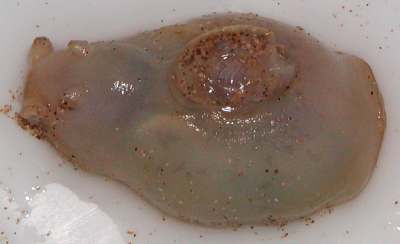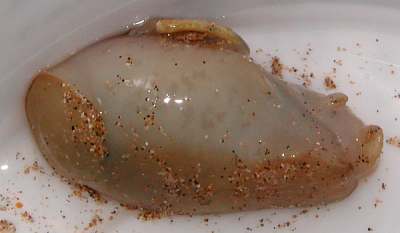Sea Hare from Hawaii
August 25, 2003
From: Dee Wamock


Aloha,
Found this creature on Kamaole Beach 1 in South Maui, Hawaii, this morning Friday 22 August 03, washed up on the sandy beach as tide receding. After ascertaining that it was, unfortunately, lifeless, took it home, took pics which I've attached 2. My only reference book is HAWAII'S SEA CREATURES by John P. Hoover and I'm an amateur with lots of questions. The book briefly describes a few cephalaspideans and although my find is colorless, the picture of Haminoea cymbalum in the book looked similar enough in general structure to make me believe I may have found a type of bubble shell. Do they lose color after death or would this just be a colorless species? I can see a faint dark-greenish shadow and mottling inside. Are bubbles soft on the exterior, because when I gently probe with a toothpick, it is fleshy-soft on the exterior, except for a hard spot on the little flap on its back. Or is it something totally different?
My name is Dee and I live next to the beach on Maui and walk it most mornings and also snorkel and dive our reef but haven't seen many sea slugs. As I learn more I may be able to spot them better. I am not a trained biologist, my BA is in anthropology but I've always been fascinated with nature and wanted to find answers and know about things. Haven't tried to dissect my find yet (it's in the fridge). My husband would probably appreciate my figuring out what this is right away so it leaves the kitchen but I have to know so will await enlightenment...
Thanks for any help.
BeachDee@hotmail.com
Wamock, D., 2003 (Aug 25) Sea Hare from Hawaii. [Message in] Sea Slug Forum. Australian Museum, Sydney. Available from http://www.seaslugforum.net/find/10826Dear Dee,
This is a Sea Hare. It is definitely dead and beginning to swell as decomposition occurs. The flap on the back is the mantle, and the hard plate inside is the thin shell. The mantle and shell are usually covered, or partially enclosed by parapodial flaps, but I guess they have partly rotted away. From the lower photo you can see a sort of disc at the back of the foot. This would suggest this is Aplysia juliana, but I can't be 100% sure. If you follow the links indicated you will find planty on the Forum about Sea Hares
Best wishes,
Bill
Related messages
-
Aplysia from Bay of Bengal
From: Rajesh Kumar, May 5, 2010 -
Re: Food of Aplysia from Hawaii
From: Kate Werner, January 13, 2009 -
Re: Food of Aplysia from Hawaii
From: Kate Werner, January 12, 2009 -
Re: Aplysia brasiliana from Texas, Gulf of Mexico
From: Georgia Doyle, October 9, 2008 -
Strange phenomenon with Sea Hare
From: Ute Duvenhage, February 19, 2008 -
Re: Sea hare being eaten by crab - Reunion Is.
From: Hugues Flodrops, February 9, 2008 -
Re: Slugs of my childhood - Baja California
From: Jeff Goddard, November 10, 2005 -
Slugs of my childhood - Baja California
From: Alicia Sarun, November 9, 2005 -
Why are they called Sea Hares?
From: Bill Rudman, May 14, 2005 -
Dangerous to dogs, yes, but what about to people?
From: John Vincent, April 13, 2005 -
Unknown worm mass
From: Rick Eastwood, February 10, 2004 -
Sea Hares - strange behaviour.
From: Krista Recsei, January 12, 2004 -
Aplysia in Thailand
From: Dunyaporn Trachootham, December 1, 2003 -
Re: Sea Hares and Red Tides
From: Josh Anderson, November 20, 2003 -
Sea Hares & Red Tides
From: Josh Anderson, November 19, 2003 -
Re: Sea Hare from Hawaii
From: Dee Wamock, October 8, 2003 -
Sea Hare eggs
From: Angie Jones, September 12, 2003 -
Are Sea Hares in Mexico edible?
From: Pepe Herrera, August 11, 2003 -
Sea Hares [Aplysia] in Channel Ids
From: Stephen R Hoskins, February 18, 2002 -
Genetic phylogeny of Aplysia in the UK
From: Stephen Hoskings, February 8, 2002 -
Genetic Studies of Sea Slugs
From: Eric Diano, March 26, 2001 -
Information about Sea Hares
From: Ray and Danny, March 12, 2001 -
Overview of Aplysia reproduction
From: Moira Rankin, December 30, 2000 -
Sea Hares & egg laying
From: L. Rivard, October 17, 2000 -
Participant information
From: Sara Black, October 5, 2000 -
Where can I find an Aplysia book?
From: Suzanne Grosso-Mennecke, September 29, 2000 -
Sea Hares and Tide Pools
From: Will Akers, September 24, 2000 -
More Sea Slug Hitchhikers
From: Andrew Trevor-Jones, September 23, 2000 -
I need information on Sea Hares
From: Chantelle, July 13, 2000 -
Learning in Aplysia
From: Raphaël Favre, June 29, 2000 -
Swimming Aplysia from Philippines
From: Erwin Koehler, June 24, 2000 -
Galapagos Sea Hare
From: Mark Blum, June 19, 2000 -
Sea Hares from the Red Sea
From: Alaa youssry Moustafa, May 25, 2000 -
'Teeth' in the gut of Bursatella
From: Jack Rudloe, March 10, 2000 -
Aplysia Osmoregulation
From: Myrtle, February 25, 2000 -
Aplysia from Japan
From: Yasuhiro Shirai, February 17, 2000 -
Anatomy of Aplysia
From: Sylvia E. Jones, January 28, 2000 -
What is this?
From: FAbienne Bovis, January 3, 2000 -
Sea Hare information
From: alexis, November 13, 1999 -
Where in Europe is Aplysia available ?
From: Ulrich Storz, November 7, 1999
